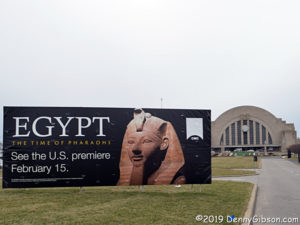 The renovated Cincinnati Museum Center takes another step at getting back in the swing of things by hosting the U.S. debut of Egypt: The Time of Pharaohs. The exhibit is new but the objects in it are anything but. Some of the 350+ artifacts on display are more than 4,500 years old. 4,500 years isn’t old like a colonial era cabin, or a New Mexico pueblo, or even a European castle. No, we’re talking old like a pyramid which is, of course, where some of these items come from.
The renovated Cincinnati Museum Center takes another step at getting back in the swing of things by hosting the U.S. debut of Egypt: The Time of Pharaohs. The exhibit is new but the objects in it are anything but. Some of the 350+ artifacts on display are more than 4,500 years old. 4,500 years isn’t old like a colonial era cabin, or a New Mexico pueblo, or even a European castle. No, we’re talking old like a pyramid which is, of course, where some of these items come from.
 I was there Friday evening for a members only event. It was a well attended members only event. Part of me was really happy to see that lots of people support the museum with their memberships and that same part was really happy to see that lots of those members also support special extra cost exhibits such as this one. Another part of me kind of wished all those people would just get out of my way.
I was there Friday evening for a members only event. It was a well attended members only event. Part of me was really happy to see that lots of people support the museum with their memberships and that same part was really happy to see that lots of those members also support special extra cost exhibits such as this one. Another part of me kind of wished all those people would just get out of my way.
I was smiling when I wrote that last sentence. Timed entries kept the exhibit from being overrun but attendees were not being hustled through it. The crowd simply meant I had to occasionally wait a bit to read a placard or study an artifact up close. It also meant that most photos I took had one to twenty people in them but just about every one of those people was seriously curious and that’s a very good thing.
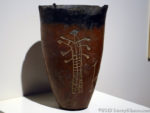

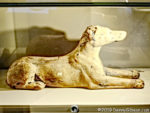 Based mostly on Hollywood movies, my idea of Egypt includes a lot of gigantic stone things like the Sphinx and those pyramids. But, almost immediately I found a wooden jackal, a bronze cat, and a clay cup. A sign next to the cup dates it to the 1st half of the 3rd millennium BCE. The 2nd half of the 3rd millennium BCE started 4519 years ago. By comparison, the cat is almost modern. It’s from the 3rd century BCE. The jackal is from around 1000 BCE.
Based mostly on Hollywood movies, my idea of Egypt includes a lot of gigantic stone things like the Sphinx and those pyramids. But, almost immediately I found a wooden jackal, a bronze cat, and a clay cup. A sign next to the cup dates it to the 1st half of the 3rd millennium BCE. The 2nd half of the 3rd millennium BCE started 4519 years ago. By comparison, the cat is almost modern. It’s from the 3rd century BCE. The jackal is from around 1000 BCE.
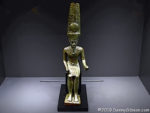
 These bronze statues are just a few inches tall and quite detailed. That’s Amun-Ra on the left and Isis on the right with a sun disk on her head and Horus on her lap. I didn’t catch a date for the Amun-Ra statue. The Isis statue is from the 6th to 3rd centuries BCE.
These bronze statues are just a few inches tall and quite detailed. That’s Amun-Ra on the left and Isis on the right with a sun disk on her head and Horus on her lap. I didn’t catch a date for the Amun-Ra statue. The Isis statue is from the 6th to 3rd centuries BCE.
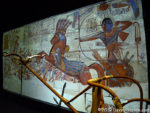

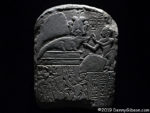 My Cecil B. DeMille based ideas weren’t entirely wrong; The Egyptians did do a fair amount of stone carving. The first stele features the crocodile god Sobek. It was carved sometime between roughly 1290 and 1190 BCE during the 19th Dynasty. I screwed up and got no information on the second stele. The third picture shows a plaster cast of a carved wall of the Temple of Amun-Ra at Karnak. The plaster cast is 135 years old. Like the first pictured stele, the wall was carved during the 19th Dynasty. The casting is a solid grey. The colors are from a projector that cycles on and off to show the wall as it was originally. A replica of a 13th century BCE chariot stands in front of the wall.
My Cecil B. DeMille based ideas weren’t entirely wrong; The Egyptians did do a fair amount of stone carving. The first stele features the crocodile god Sobek. It was carved sometime between roughly 1290 and 1190 BCE during the 19th Dynasty. I screwed up and got no information on the second stele. The third picture shows a plaster cast of a carved wall of the Temple of Amun-Ra at Karnak. The plaster cast is 135 years old. Like the first pictured stele, the wall was carved during the 19th Dynasty. The casting is a solid grey. The colors are from a projector that cycles on and off to show the wall as it was originally. A replica of a 13th century BCE chariot stands in front of the wall.

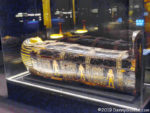
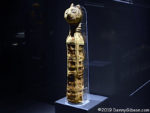 Of course, you can’t have an Egyptian exhibit without a sphinx and some mummies. This limestone sphinx is a baby just a couple of feet long. It’s from the 3rd to 1st centuries BCE. The coffin is from the 14th or 15th centuries BCE. It’s a mix of wood and plaster with gold trim. The mummified cat comes from the same time period as the sphinx.
Of course, you can’t have an Egyptian exhibit without a sphinx and some mummies. This limestone sphinx is a baby just a couple of feet long. It’s from the 3rd to 1st centuries BCE. The coffin is from the 14th or 15th centuries BCE. It’s a mix of wood and plaster with gold trim. The mummified cat comes from the same time period as the sphinx.
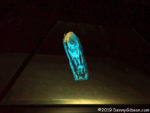
 There is actually plenty of modern technology mixed in with the multi-millennium old artifacts. An audio guide is available that provides commentary keyed to specific displays. There are several interactive exhibits that help explain timelines, hieroglyphics, and more. The final display is pretty high-tech. High resolution CT scans have recorded the details of every layer of a mummy from about 750 BCE. Holography is used to project a rotating 3-dimensional image inside a clear pyramid. The image cycles through the layers as it rotates. It’s a time warp that even Doc Brown might appreciate.
There is actually plenty of modern technology mixed in with the multi-millennium old artifacts. An audio guide is available that provides commentary keyed to specific displays. There are several interactive exhibits that help explain timelines, hieroglyphics, and more. The final display is pretty high-tech. High resolution CT scans have recorded the details of every layer of a mummy from about 750 BCE. Holography is used to project a rotating 3-dimensional image inside a clear pyramid. The image cycles through the layers as it rotates. It’s a time warp that even Doc Brown might appreciate.
Egypt: Time of the Pharaohs is at the Cincinnati Museum Center through August 18.
